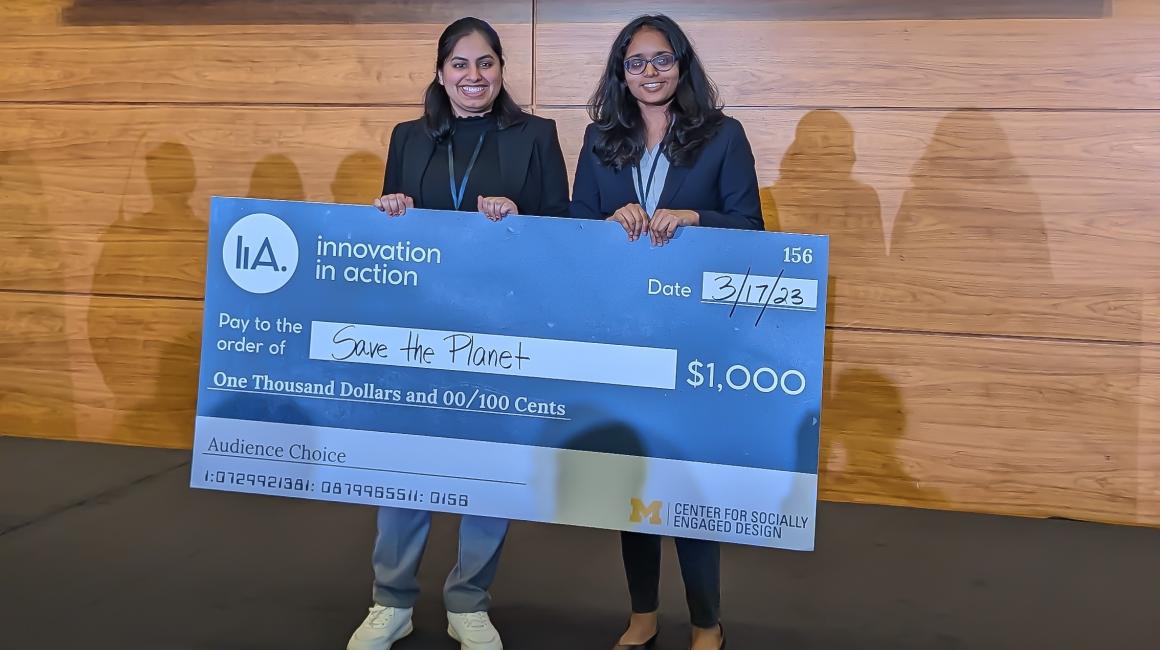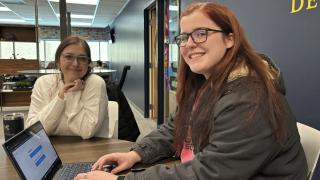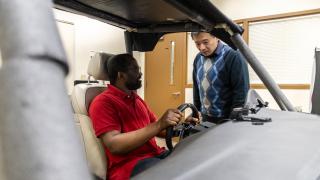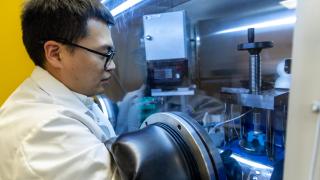
It’s no easy feat to score a prize in the University of Michigan’s Innovation in Action design challenge, an annual competition where student teams design and develop a solution to a real-world problem they are passionate about. The challenge is open to students from all the U-M campuses, in all disciplines, so competition is stiff. And unlike hackathons or idea pitch competitions, the Innovation in Action challenge lasts a full five months. Part of the reason for the marathon timeline is that organizers want students to experience as many stages of the innovation process as possible, from talking with potential users or customers, to making many rounds of revisions, to prototyping and development. For Kruthika Gopinathan and Richa Chachara, the only UM-Dearborn students in the competition, the commitment and hard work paid off: They won the Audience Choice Award and a $1,000 cash prize for their mobile app that helps customers reduce their electricity usage and save money.
Gopinathan and Chachara are equally passionate about environmental issues and data science, and their app represents an artful mingling of both. They kicked off their design process with a customer survey, so they could better understand people’s attitudes toward their energy consumption. Gopinathan says one of the most revealing findings was learning that about 80% of their respondents never thought about their energy use. Gopinathan and Chachara hypothesized that this was in large part because that information is not part of our everyday lives: We get the electricity bill once a month; if we’re on auto-pay, we may never even see it. If our relationship to energy wasn’t so out of sight, they thought, it might not be so out of mind.
Chachara and Gopinathan found some creative ways to put that information in front of people and inspire conservation behaviors. First, they used data that DTE Energy collects through its smart meters to provide app users an easy-to-digest breakdown of their energy use, including areas of their homes that are consuming the most energy. For example, users can view a month-to-month comparison of their energy use, broken down by categories like heating, cooling, lighting and laundry. When you've passed last month's usage, you get a notification nudging you to conserve. Similarly, you get a congratulatory message if you consumed less than previous months. The app also has built-in functionality for a points-based rewards system, where users can redeem points for things like gift cards.
One of the most novel features focuses on time-of-day pricing. Last month, DTE Energy rolled out a new pricing system that charges customers higher rates for electricity they consume during times of peak demand. For consumers, it can be a confusing adjustment, but Chachara and Gopinathan’s app makes it easy. Using color-coded graphs, users can quickly see when it’s cheaper to use electricity, and whether they’re typically consuming during peak or off-peak times.
Chachara and Gopinathan both learned a lot from participating in the competition. If they had to do it over again, they say they’d take some cues from the other teams and spend a lot more time talking to potential customers and going through multiple iterations of their product based on that feedback. “I would say we did what we wanted and then asked people about it, rather than first approaching people about what they needed or wanted and then designing around that,” Gopinathan says. She and Chachara also noted they’ve grown a lot as “storytellers,” which is helping them build presentations that are not only technically sound but also compelling. “I feel like any presentation or research paper or assignment I work on now, I really try to build up the story,” Gopinathan says. “You can have really strong technical knowledge, but if you really want your idea to have an impact, you need to be able to explain it in a way that is going to make others feel as strongly as you do.”
###
Check out more winning projects from the Innovation in Action competition. Story by Lou Blouin



